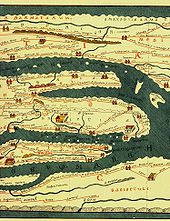Itinerary
An Itinerar (n., From Latin itinerarium , pl. Itineraria or, more recently , itinerary , derived from Latin iter “way”) is generally the comprehensive representation of traffic routes and roads . But also street and station directories, hotel information, means of transport, tickets - actually all information belonging to a trip - for travelers, hikers, merchants or pilgrims are meant. Travel descriptions and protocol compilations of trips by well-known and important people are also designated in this way. Occasionally, a small altar that was taken when traveling is also referred to as an Itinerar .
Old Orient
Mesopotamian texts with travelogues are considered to be the earliest itineraries .
Roman Empire / Late Antiquity
The following are preserved from the Roman Empire and Late Antiquity :

- the Itinerarium Antonini with the Itinerarium provinciarum , a number of travel routes through the Roman provinces of Europe, Asia and Africa (from the 3rd century),
- the Itinerarium Burdigalense (or Hierosolymitanum ), written in 333/334 by a Christian pilgrim for the route from Bordeaux to Jerusalem ,
- the Itinerarium Alexandri , a brief description of the route of the Alexanderzug to Persia written around 340 ,
- the Itineraria Gaditana , a listing of the route sections from Gades to Rome ,
- the Tabula Peutingeriana , a Roman road map from the 4th century,
- the itinerary of the anonymous pilgrim from Piacenza about his pilgrimage to the Holy Land , around 570.
The often so-called Itinerarium Egeriae , also known as Peregrinatio Aetheriae , a report written by the pilgrim Egeria about her trip to the Holy Land in the late 4th century, is not an itinerary, but a letter report.
middle Ages
- Itinerarium Regis Ricardi , Latin prose story about King Richard I of England and his participation in the Third Crusade ,
- Itinerarium Einsidlense (kept in the library of Einsiedeln Abbey , Switzerland), see Rome pilgrimage guide ,
- Itinerarium sive peregrinatio excellentissimi viri artium ac utriusque medicine doctoris Hieronimi Monetarii de Feltkirchen civis Nurembergensis, travel report of a pilgrimage to Santiago de Compostela by Hieronymus Münzer from the years 1494/1495.
Reformation time
From the time of the Reformation there is an extensive itinerary penned by the Augsburg preacher Wolfgang Musculus (1497–1563), which documents the route from Augsburg to Wittenberg . The Raißbüchlin Jörg Gails was of importance beyond the Reformation . It appeared in Augsburg in 1563 and covered routes across Europe.
History
In the technical jargon of historical studies , an itinerary is understood to be the "travel route" of rulers or their scientific documentation on the basis of the dates and locations of issue of documents as well as information in the historiography . The reconstruction of stays and journeys made by early and high medieval rulers is particularly useful , as these rulers did not, as a rule, exercise a residential rule , but were traveling from one Palatinate to the next as traveling kings ( Königsitinerar ). The result, which can also be displayed as a map, is helpful for historical work; Fake documents can now also be recognized by the fact that the place of issue falls completely outside of the recreation area to be reconstructed from the itinerary. It also shows which places and regions were important for the ruler and his ruling practice.
A more recent, more prominent example of modern history is the Hitler Itinerary by Harald Sandner , which took decades of work .
Spiritual literature
In spiritual literature, itinerary can also mean a guide that should lead to a right conduct of life, up to perfection. The best-known example is Bonaventura's Itinerarium mentis in Deum (1259).
literature
- Karlheinz Kessler , Jan Burian : Itineraries. In: The New Pauly (DNP). Volume 5, Metzler, Stuttgart 1998, ISBN 3-476-01475-4 , Sp. 1178-1182.
- Georg Röwekamp : Itinerarium . In: Lexicon of ancient Christian literature . 2nd Edition. Herder, Freiburg 1999, ISBN 3-451-23786-5 , pp. 323-324.
- Marc Löwener: Itineraries as an aid for the chronological classification of the source material - illustrated using the example of the establishment of the rule of the Teutonic Order in Prussia. In: Irene Erfen , Karl-Heinz Spieß (ed.): Strangeness and travel in the Middle Ages. Franz Steiner, Stuttgart 1997, ISBN 978-3-515-06904-5 , pp. 165-176.
Web links
- History of cartography
- Itineraria. More than 1400 volumes digitized. In: Göttingen Digitization Center . Retrieved April 10, 2020 .
Individual evidence
- ^ Gundolf Keil , Marianne Wlodarczyk: Münzer, Hieronymus. In: Author's Lexicon . 2nd ed., Vol. 6, 1987, col. 800-804; here: Col. 801 f.
- ↑ Henning Reinhardt: The Itinerar of Wolfgang Musculus . In: Archiv für Reformationsgeschichte 97, 2006, pp. 28–82. See also Herbert Krüger: The oldest German route handbook. Jörg Gail's "Raißbüchlin" (from 1563). With 6 route maps and 272 original pages in facsimile. Academic Printing and Publishing Company, Graz 1974.
- ↑ Cf. as an example: Günther / Krüger / Zorawaska-Wilkowska: The journeys and stays of King August II (of Poland = August the Strong , Elector of Saxony) , in: Under a crown . Leipzig 1997, pp. 49–53, as well as ibid. The journeys and stays of King August III. (of Poland = Elector Friedrich August II of Saxony ) , pp. 58–63.
- ↑ Hitler - Das Itinerar. Places of residence and journeys from 1889 to 1945 , 4 volumes, 2432 pages, 2211 illustrations, Berlin 2016
- ↑ Bonaventura, Itinerarium mentis in Deum : online Latin
